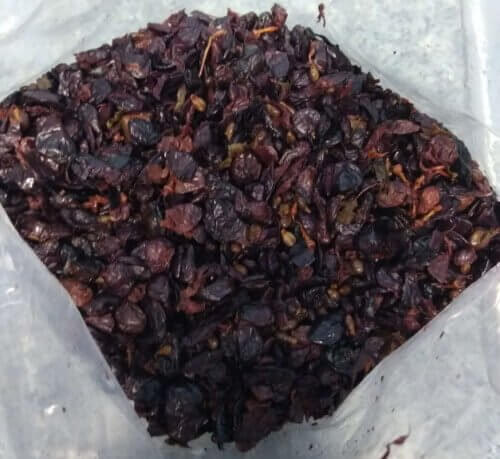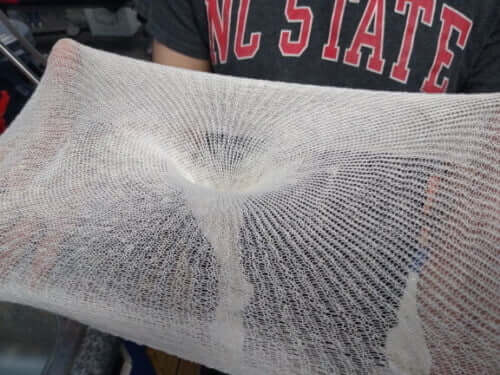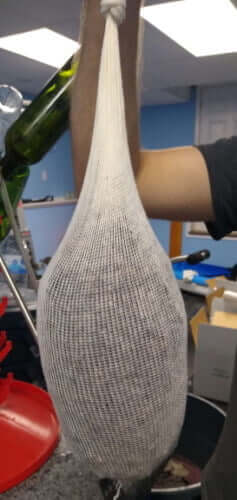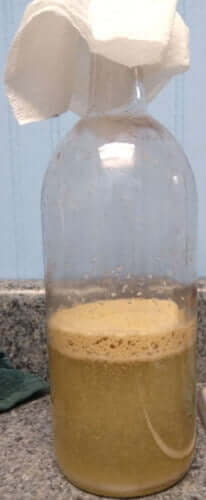2021 FWK Super Tuscan in Detail
Last updated 12/04/2022
I had not planned to write another “in Detail” blog, but the crazy rapid fermentation of the Rhone Blend has pushed me to try a few things to slow down the ferment of this Super Tuscan. And that pushes me to write another blog.
As with the previous blogs in this series, I will be focusing on points not covered in the previous blogs. Yes, many of the same points will be covered, but the focus is on efforts to slow down the ferment.
Important Note: FWK are not pasteurized, so they are not shelf stable! They must be kept chilled or frozen prior to use, or it is entirely possible a spontaneous fermentation can occur within the juice/concentrate bag.
Menu (Dates of Activity)
| 11/17/2021 | 11/22/2021 | 07/16/2022 |
| 11/18/2021 | 11/23/2021 | 08/14/2022 |
| 11/19/2021 | 11/24/2021 | 11/05/2022 |
| 11/20/2021 | 02/10/2022 | 11/27/2022 |
| 11/21/2021 | 03/16/2022 |
11/17/2021



The kits arrived in late afternoon, in good shape. As with the Rhone Blend kits, the concentrates are very thick and partially frozen, which is good.
Starting the kits went very smoothly. Eric & I work well together — we tend to think alike and a lot of communication is not always necessary. We learned a lot starting the Rhone Blend, and we both remembered those lessons tonight.
We did things a bit out of order from the FWK instructions.
First we cleaned the winemaking area, including arranging the kit materials. We dropped the muslin bags for the grape skins in a bucket and doused with K-meta, then squeezed them out. These will set for 15-20 minutes until we are ready for them.
Eric put 3 tsp ScottZyme ColorPro into the fermenter. Then he opened the first concentrate bag and emptied as much as he could into the fermenter. It was thick and we used an entire gallon of water rinsing the bag out. This is fine as 3 kits require 13.2 gallon of water to reconstitute them. We cycled through the other 2 bags, then added the remaining water.
Next we added Yeast Nutrient Packet A, grape seeds, and oak chips. Eric stirred with the drill-mounted stirring rod, about a minute in one direction, then reversing for a minute. The must will continue to mix overnight. I checked the SG, but it was foamy so I didn’t get a good reading. It looked like 1.100, which is right on target.
Next we put the grape skin packs into the bags. This can be done by one person, but it’s a LOT easier with two. I cut a bag open (using scissors) while Eric spread a bag wine open. I dumped the contents into the bag, flicking the plastic with a finger to get a few stubborn pieces to drop. Eric knotted the bag and dipped it into the must. We pounded through 6 bags in short order.
Finally we created the yeast starter — we put all 3 nutrient packet B’s into a 1.5 liter wine bottle along with 3 tsp Avante yeast. Then added 2 cups water and shook to stir. This will be poured into the must tomorrow.
I purchased 500 g of Renaissance Yeast’s Avante (formerly called Andante) for the red grapes we planned. This was recommended as it doesn’t produce hydrogen sulfide (H2S), which part of last year’s 2nd run wines developed.
In the long term, it was cheaper to purchase the brick than to buy 2 “barrel” size packages. The brick is $70 USD while two “barrel” size packages would cost $32, and I’ll be able to use the brick for several years if I keep it well frozen. Since I’m making overnight starters, I’ll know if the yeast goes bad, as the starter won’t grow. Plus I sold 150 g to another winemaker at cost, so my cost for the brick was reduced to $50.
According to the vendor it’s recommended for Cabernet Sauvignon, Zinfandel, Syrah and Sangiovese. The Super Tuscan contains Grenache, Syrah, Cabernet Sauvignon, and Merlot (I believe this is correct), so it’s as good a yeast as RC212, and I have a LOT of it.
11/18/2021

The room temperature was a balmy 67.4 F and the starter looks really good. I swirled the bottle to mix it up. Since the SG is right at 1.100, I inoculated by pouring the contents carefully along the side of the fermenter, just above the must.
Looking at the bottle, I saw residue in the bottom, nutrient that had not been mixed up. I used a wine thief to extract juice, added it to the bottle, and shook it well to mix the nutrient, then added that to the fermenter in a different spot. This was to avoid spreading the starter unnecessarily.
Then I realized I hadn’t checked temperature.
62.8 F, lower than I expected.
I am hoping I didn’t screw up by not waiting until the must is a bit warmer. However — if the fermentation doesn’t ignite, I have a LOT of Avante left, so I will make another starter.
A lot of folks keep an extra packet of Lalvin EC-1118 on hand for emergencies. EC-1118 is a general purpose, work horse yeast with a high alcohol tolerance (18%). While a red wine yeast will produce different nuances in the wine, EC-1118 is usually included in kits as it’s the most foolproof yeast there is, hard to kill, and as I’m wont to say, it will ferment a rock if it is given a chance.
Finer Wine Kits stands out as they included RC212 in their red kits and D47 in their white kits. These are commonly used yeasts specific to red and white wines, respectively.
At this time I have 3 packets of RC212, 2 packets of QA23 (which I purchased for the white juices we planned to buy), and over half the brick of Avante. I have plenty of yeast if I need to make another starter!
11/19/2021
It appears the fermentation has kicked in, if a bit slower than previous ones, probably due to temperature. The room is 64.7 F, the must is 65.6 F, and the SG dropped to 1.099. I see a bit of foam between the skin bags, and they are floating a bit higher than yesterday, although they are not yet puffy with CO2.
11/20/2021
Fermentation is well underway. The SG is 1.089 and the temperature is 68.4 F. I’m going to start adding frozen bottles when the temperature hits 72 F.
11/21/2021
I was busy all morning so I didn’t have an opportunity to check the wine until 4:00 PM. The must temperature was 76.8 F and the SG was 1.030.
Whoops! A 59 point drop in about a day-and-a-half. But the temperature didn’t spike like the previous batches.
I added a frozen 16 oz water bottle. Checking an hour later, it was melted and the temperature was down to 75.5 F, so I chose to not add another.
11/22/2021
This morning the must temperature was down to 74.8 F and the SG is at 1.015. This is consistent with the Rhone, where it took off and fermented rapidly, then slowed down at the end. I have more bottles frozen, but I don’t see a need to use them, as the temperature is in a range I’m satisfied with.
I realized I had not added Nutrient Packet C, which I should have added yesterday. Oh, well, added it at 8:00 AM. The wine may ferment for several more days so it’s worth adding it. Besides, I have no idea what is in the packet, so I won’t use it in another wine as the Packets A, B, and C are designed to work together. I wouldn’t know what to add in addition to C if I tried it in another wine.
11/23/2021
The room temperature was a balmy 66.5 F and the must was 70.2 F. The SG measured at 1.001.
When I punched down the skin bags, the wine foamed, but less than yesterday and the foam cleared quickly. Eric can come to the house tomorrow after work, so we’ll rack and press the bags then.
My attitude on the rapid ferments has relaxed as I have reviewed my notes. I have formed the opinion that temperature needs to be controlled, but the rapid ferment may not be a problem. It’s harder to track as things change quicker, so adding Nutrient Packet C requires more SG checks.
In 6 and 12 months I’ll check the wines and see what they are like. The Barbera and Chardonnay will be checked at bottling time (I expect to bottle ~6 months after start), while the Rhone and Super Tuscan will be in barrels, so the 6 month check will be in-barrel and the 12 month check will be at bottling time.
11/24/2021
The SG was at 0.998 in the evening, so Eric & I racked, then pressed the skin packs. The pressing netted almost 1.5 liter of wine. The wine is in a 54 demijohn and 19 liter carboy, both with a lot of headspace. This is temporary as the wine naturally degasses.
02/10/2022
 Eric & I are bottling the barrels this weekend, and this one and the Rhone blend will go into the barrels along with 4.5 oz oak cubes. I need to ask what oak is included in the kits.
Eric & I are bottling the barrels this weekend, and this one and the Rhone blend will go into the barrels along with 4.5 oz oak cubes. I need to ask what oak is included in the kits.
Like the Rhone, this one had only fine lees (yeast hulls). I expected fruit solids and was going to rack in December, but didn’t see the point.
The SG never dropped, which surprised me — I expected it to drop another couple of points.
The color is amazing — I need to compare pictures with folks on WMT, but it appears the ScottZyme ColorPro does the trick!
Note: I never added the fining agents, and at this point I’m not going to.
03/16/2022
In the past I didn’t track how much wine I used to top the barrels, but am doing it in this blog so I’ll have a record.
I used about 1 oz less than 750 ml wine to top the barrel. Since the Rhone needed just a bit more than 750 ml, I used the excess from this wine in the other barrel. As noted in it’s blog, 1 oz in 14.25 gallons is insignificant, and it enables me to properly top the barrels.
07/16/2022
Four months later, I’m finding that keeping the blog up to date is simply not happening (especially since I’m typing this in November).
On this date I noted that I topped the barrel with 2.25 bottles of wine, as I had not checked it in almost 8 weeks. The cellar warms up in the summer, which increases evaporation through the wood. Air in the barrel is not a problem, as I had to really fight to get the bung out due to the vacuum produced by the evaporation — water and alcohol exit the barrel, nothing replaces it, so a vacuum is formed. This is good.
08/14/2022
Today I topped the barrel with 1.25 bottles of wine.
11/05/2022
I topped the barrel in early September, but didn’t record the date, although I recall it took 1 bottle.
Today is bottling day, for most of the wine. We pumped the wine out of the barrel into a Brute, all but the last couple of liter. To the Brute we added the unoaked topup wine from two 4 liter jugs plus a couple of smaller bottles.
The dregs from the barrel and smaller bottles was placed in a 19 liter carboy, to which we added 1/4 tsp K-meta and a packet of Kieselsol. We then filled the carboy with homogenized wine from the Brute. At the 3/4 full point we added a packet of Chitosan. This wine is being set aside — we’ll rack and bottle it in 2 to 4 weeks.
This carboy is an experiment to see how much sediment the K&C pulls from a supposedly clear wine, and to compare against the unfined wine to determine if the K&C affects the color, body, aroma, and flavor.
The Brute contains approximately 11.5 US gallons of wine, so we added a slightly heaping 1/2 tsp K-meta and 8 oz glycerin. This was stirred very well.
Next we carried the barrel up front, where we power washed it, inside and out. The oak cubes were retained — they will be dried and used in the smoker. Finally we added 1/2 lb Oxyfresh BarrelClean to the barrel and filled it with water. This will soak for 4 hours.
Note: We later noticed that the stain around the bung hole was greatly faded, just by having some of the solution overflow the barrel. This stuff works really well!
Leaving the barrel, we returned to the cellar for bottling. We stirred the Brute again, to ensure the glycerin was well mixed, then bottled 55 bottles.
After 4 hours we drained the barrel, rinsed it, and filled it with 2022 wine (Grenache or Tempranillo).
11/27/2022
Patrick & I reserved 3 bottles of wine from the fined carboy, to use for making Port. We bottled the remainder, adding 1/4 tsp K-meta and 4 oz glycerin.
